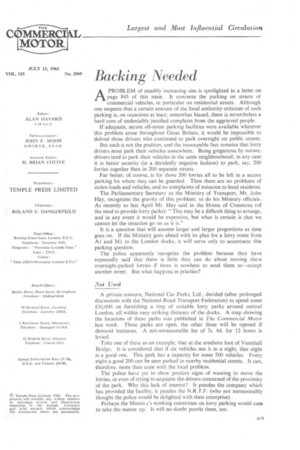Backing Needed
Page 25

If you've noticed an error in this article please click here to report it so we can fix it.
APROBLEM of steadily increasing size is spotlighted in a letter on page 845 of this issue. It concerns the parking on streets of commercial vehicles, in particular on residential streets. Although one suspects that a certain amount of the local authority criticism of such parking is, on occasions at least, somewhat biased, there is nevertheless a hard core of undeniably justified complaint from the aggrieved people.
If adequate, secure off-street parking facilities were available wherever this problem arose throughout Great Britain, it would be impossible to defend those drivers who continued to park overnight on public streets.
But such is not the position, and the inescapable fact remains that lorry drivers must park their vehicles somewhere. Being gregarious by nature, drivers tend to park their vehicles in the same neighbourhood; in any case it is better security (in a decidedly negative fashion) to park, say, 200 lorries together than in 200 separate streets.
Far better, of course, is for those 200 lorries all to be left in a secure parking lot where they can be guarded. Then there are no problems of stolen loads and vehicles, and no complaints of nuisance to local residents.
The Parliamentary Secretary to the Ministry of Transport, Mr. John Hay, recognizes the gravity of this problem; so do his Ministry officials.
As recently as last April Mr. Hay said in the House of Commons (of the need to provide lorry parks): "This may be a difficult thing to arrange, and in any event it would be expensive, but what is certain is that we cannot let the situation go on as it is."
It is a question that will assume larger and larger proportions as time goes on. If the Ministry goes ahead with its plan for a lorry route from Al and M1 to the London docks, it will serve only to accentuate this parking question.
The police apparently recognize the problem because they have repeatedly said that there is little they can do about moving these overnight-parked lorries if there is nowhere to send them to—except another street. But what happens in practice?
Not Used A private concern, National Car Parks, Ltd., decided (after prolonged discussions with the National Road Transport Federation) to Spend some £10,000 on furnishing a ring of suitable lorry parks around central London, all within easy striking distance of the docks. A map showing the locations of these parks was published in The Commercial Motor last week. Three parks are open, the other three will be opened if demand increases. A not-unreasonable fee of 7s. 6d. for 12 hours is levied.
Take one of these as an example, that at the southern foot of Vauxhall Bridge. It is considered that if six vehicles use it in a night, that night is a good one. This park has a capacity for some 500 vehicles. Every night a good 200 can be seen parked in nearby residential streets. It can, therefore, more than cope with the local problem.
The police have yet to show positive signs of wanting to move the lorries, or even of trying to acquaint the drivers concerned of the proximity of the park. Why this lack of interest? It puzzles the company which has provided the facility, it puzzles the N.R.T.F. (who not unreasonably thought the police would be delighted with their enterprise).
Perhaps the Ministty's working committee on lorry parking would care to take the matter up. It will no doubt puzzle them, too.












































































































